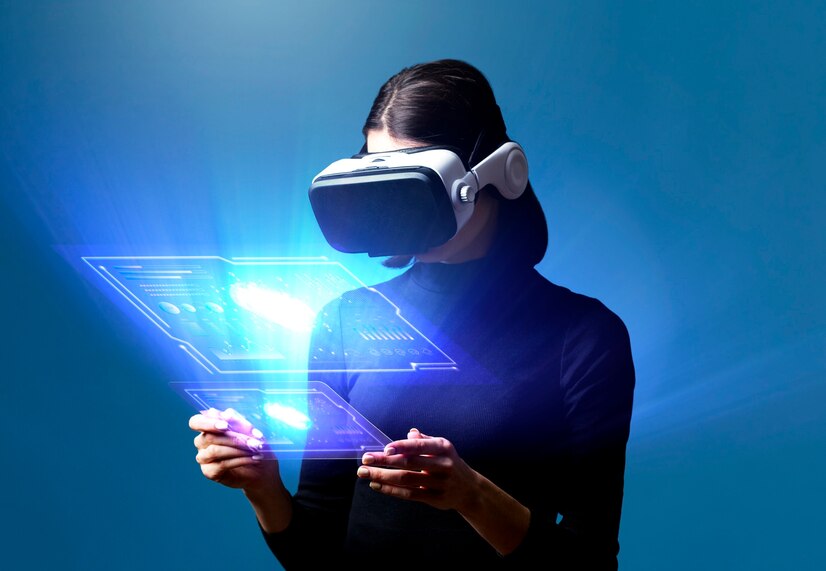Modern gaming has undergone a significant transformation because technological developments have expanded real-life gaming possibilities. The gaming development industry underwent transformation through augmented reality (AR) and virtual reality (VR) technology which created fully immersive gameplay experiences for players. The gaming industry will receive a dramatic change from AR and VR technologies when 2025 arrives since these technologies will boost realism alongside player engagement and interaction capabilities. The advancement of game development introduces developers to implement realistic physics with AI-controlled characters while creating extremely authentic game worlds. The article evaluates future gaming realism using 2025 projections on AR and virtual reality development.
1. Ultra-Realistic Graphics and Visuals
The advancement in game development gains its largest progress through visual advancements. By the year 2025, AR and VR technologies will deliver graphics that approach the standard of real-world environments. Modern video games achieve superior levels of world detail with the combination of high-resolution textures and ray-tracing technology alongside AI-generated visual content. Next-gen GPUs make it possible to render complex scenes in real-time which provides gamers with an uninterrupted gaming experience.
Augmented reality functions by rendering digital info that merges virtual things with actual environmental elements. Customers benefit from better interaction and deeper immersion because of the combined systems in AR gaming. Virtual reality destinations fully absorb players into virtual spaces through 8K displays along with sophisticated shading technology to create virtual realities that mimic real-world experiences. Video games entering 2025 will achieve graphic excellence that makes digital spaces and reality virtually indistinguishable from each other.
2. AI-Driven Characters and Enhanced NPC Interactions
Game development using artificial intelligence technology enables interactive non-playable character (NPC) functions with players. Advanced AI algorithms installed in AR and VR games during 2025 will permit NPCs to develop thinking abilities and learn and adapt through monitoring player actions. Virtual characters powered by artificial intelligence technology will deliver life-like responses which improves storytelling immersion and offers more engaging narratives.
AI-powered non-player characters in augmented reality games will recognize both gestures and commands through speech and express emotions when interacting with real-world components. VR games will employ deep-learning models that develop characters with authentic motion patterns along with natural facial expressions. In-game entities will manifest real-time intelligence alongside behavior that matches the standards of present-day reality. Game developers have implemented advanced techniques that create natural gameplay experiences through technology that unites digital and physical reality.
3. Haptic Feedback and Sensory Enhancements
Haptic feedback technology stands out as the leading advancement in AR and VR gaming during 2025 when this technology becomes widespread. Haptic suits and motion control devices together with gloves offer virtual players physical touch reactions that enhance their experience of virtual worlds. Realistic simulations of textures pressure and movement make this innovation enhance the sense of realism.
Through AR wearables users can feel physical touch because their devices provide haptic feedback when they interact with augmented content. The specialized glove technology enables players to experience feelings of virtual object texture and detect weights when they interact with augmented reality elements. An immersive gameplay experience appears through full-body haptic suits that generate impact sensations as well as temperature and vibration feedback which improves combat and both exploration and interactive stages. The integration of multi-sensory features into game development projects has brought gaming closer to becoming a perfect representation of actual reality in 2025.
4. Spatial Audio and Advanced Soundscapes
2015 represents a significant period for audio innovation because spatial audio systems will receive major technological advancements. Augmented reality and virtual reality games through 3D audio will position sounds accurately in space for a sense of environmental realism. The simulation of physical world acoustic behavior through spatial audio enables players to detect noises that originate from various locations and distant or elevated spots.
AR gaming offers a feature by which virtual sounds can be connected to specific real-world positions enabling gamers to perceive how virtual objects interact with their environment. AR applications become more real and interactive due to these additions. The advanced soundscapes within virtual reality recreate every step and whispered voice, as well as explosion, sounds exactly like real-world interactions. The development of adaptive audio engines by game studios utilizes artificial intelligence technologies to produce sound system adjustments according to player interactions with the game environment. The technological refinements in virtual reality and augmented reality gaming will achieve a degree of sound fidelity comparable to visual realism.
5. Cloud Gaming maintains a partnership with Artificial Intelligence technologies used in developing video games.
The cloud-based service will enhance AR and VR presentation in 2025 through its revolutionary innovations. Through cloud-based platforms, players gain access to high-end games that do not need expensive hardware setups. Through cloud streaming of AR and VR games, players gain update-free installation and improved performance that serves them across different devices.
The introduction of AI technology in gaming development methods changes both the operation of game development and the dynamic of gameplay. The programming community uses artificial intelligence to produce digital realities while enabling automatic movement generation and achieving better performance outcomes. Augmented reality applications show improved responsiveness since their code follows real-world scenarios naturally in real time. Through artificial intelligence, virtual reality games produce randomized world environments that provide new gameplay conditions each time a player engages with them. Gaming technology will evolve to outstanding levels of realism because of these developments which will deliver immersive and realistic AR and VR gaming to users in 2025. Contact us for more details.
Frequently Asked Questions

1. The current focus for augmented reality developers is to advance their technology until it delivers enhanced gaming realism by 2025.
The technology improves realism in augmented reality by merging digital content with actual surroundings through artificial intelligence and real-time identification of objects with spatial sound effects. Future AR games in 2025 will make users experience natural virtual interactions because they will display realistic overlaid content that adapts to real-world environments through physics-enhanced simulation.
2. The distinction between virtual reality gaming and reality will vanish in 2025.
The simulated reality of VR gaming duplication will achieve virtual absence from actual reality yet remain distinct from it. Advancements in display resolution alongside artificial intelligence NPCs and haptic systems along with spatial audio will create VR experiences that surpass previous levels of immersion and verisimilitude.
3. AI serves what functions when constructing games for AR and VR platforms?
AI constitutes a fundamental aspect in the creation of video games through virtual reality and augmented reality because it allows developers to create intelligent NPCs and produces virtual environments that seem authentic with automated content-making capabilities. Games based on artificial intelligence recognize player activities which enables them to generate customized and authentic game environments.
4. Immersive gaming experiences rely heavily on what extent haptic feedback functions provide to users.
Tactile gaming systems enable users to sense real-world pressures along with temperature variations as well as virtual material variations. Realism gets enhanced through tangible interactions which make both AR and VR environments more realistic.
5. Research the effects cloud gaming technology will produce on AR and VR by 2025.
Virtual game delivery services will expand AR and VR accessibility by removing system hardware restrictions. Online cloud gaming provides players with dependable high-quality streaming that delivers superior performance and real-time game improvements together with increased virtual reality quality no matter what device they use.
Conclusion
The upcoming Augmented reality and VR gaming scene for 2025 will replace current perceptions by creating unfathomable realistic gaming experiences. Modern graphics technology along with AI-powered actions haptic feedback systems spatial audio capabilities and cloud streaming have harmonized the distinctions between real experiences and digitally constructed dimensions. Developments within game production keep intensifying what we can achieve in order to make AR and VR gaming more realistic than ever. Gaming technology of the future reaches new heights in realness in ways that were earlier considered unachievable.

